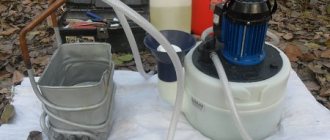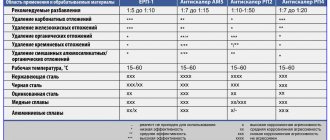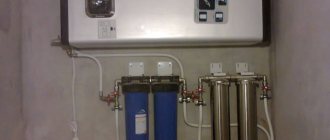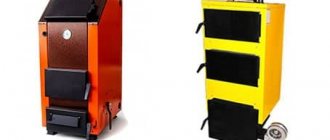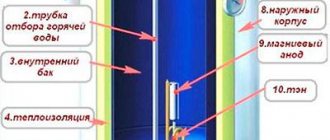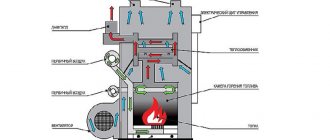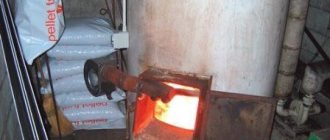Main types of boiler flushing
Boiler cleaning diagram.
By flushing boilers it is necessary to understand a whole range of activities during which, using physical or chemical methods, deposited scale is completely removed from the boiler. Today there are two main types: repair and regular. With regular flushing of boilers, a small amount of deposited scale is removed from parts of the entire boiler installation. The repair operation is performed much less frequently, that is, in cases where regular washing no longer helps.
With regular flushing there is no need to disassemble the system. The entire operation is carried out using special equipment. Thanks to this method, it is possible to prevent the formation of large amounts of scale. This way you can prevent emergencies from occurring.
It is important to carry out regular flushing of boilers to avoid mechanical damage associated with an increase in pressure inside the system due to blockages. Regular flushing should be carried out every few years, but under conditions of constant operation of the heating system, this period is recommended to be reduced
This operation can be performed on site, which significantly reduces boiler maintenance costs.
When performing repair flushing, it is necessary to completely disassemble the system. This procedure is carried out if further operation of the system is assessed as unsafe. This operation is usually carried out using the physical method, but chemical washing is also possible.
To flush boilers, special installations, or so-called boosters, are used. This installation is a complex system that consists of two blocks. The operation of such boosters, which have a simple design, is quite complex and requires taking into account many secondary factors. Such factors include the design features of the boiler installation itself, as well as the ability to adjust parameters such as the temperature and pressure of cleaning solutions in the system itself.
Washing methods
Chemical
Chemical flushing of heating systems is used in two cases:
When it is necessary to restore the functionality of the heating system of an apartment building, which has been in operation for several decades. In combination with the inevitable siltation, the overgrowth of steel pipes leads to a catastrophic drop in efficiency during this time.
The actual flushing consists of pouring a special reagent into the heating circuit instead of water. This product is a solution of alkali (most often sodium hydroxide) or acid (phosphoric, orthophosphoric, and so on).
Then a special pump in the circuit ensures continuous circulation for several hours. Then the heating system flushing fluid is drained and the system is pressure tested before being put back into operation.

This device is a reagent tank and a pump in one housing.
The cost of the cleaning product starts from 5-6 thousand rubles for 25 liters. Housing maintenance rules prohibit disposing of used solution down the drain; however, if there is no other way of disposal, solutions for their neutralization are sold along with washing compounds.
Hydropneumatic flushing
This technology for flushing the heating system has been used for many decades in the Russian (and previously in the Union) housing and communal services and has long shown its effectiveness. But only and exclusively if performed correctly.
The instructions for flushing the heating system are quite simple: the circuit is discharged into the sewer system, first from the supply to the return, then vice versa. In this case, air is pumped into the water flow by a high-power pneumatic pump. The pulp, passing along the entire contour, partially destroys the scale and removes silt.
The heating system flushing scheme used in practice in housing and communal services is as follows:
- We close the house valve on the return pipeline.
- We connect the compressor to the supply metering valve after the house valve.
- We open the reset on the return line.
- When the pressure in the ballast tank of the compressor reaches 6 kgf/cm2, open the valve to which it is connected.
- We close off groups of risers one by one so that no more than a dozen are open at any given time. In this case, flushing heating risers and heating devices connected to them will be most effective.
The duration of flushing can be easily controlled by visually assessing the degree of contamination of the water being discharged. As soon as it has become transparent, we begin to wash a new group of risers.
After all the risers are washed, we switch the heating to reset in the opposite direction:
- We close the discharge and the valve to which the compressor is connected.
- We close the house valve on the supply and open it on the return.
- We open the reset from the supply. We connect the compressor to the metering valve on the return pipeline and open it.
Next, washing the groups of risers is repeated, but with the pulp flow in the opposite direction.
Types of descaling
Cleaning boilers from scale can be done in two ways:
- dismountable when its quantity has reached critical volumes that cannot be removed in any other way, and further operation of the device is also impossible;
- non-removable, which allows you to prevent the appearance of deposits on the internal walls of the case in advance, as well as get rid of them, provided that effective cleaning means are used.
Collapsible view
The dismountable method is the most effective, but labor-intensive. It allows you not only to assess the current condition of the boiler, but also to completely get rid of scale in any suitable way: mechanical or chemical.
A step-by-step analysis of the design is performed as follows:
We study the disassembly instructions, if they are offered by the manufacturer, or the device diagram. We select the necessary tools. We prepare cleaning products and consumables for maintenance. Disconnect the boiler from the power supply and wait until it cools down to room temperature. We close the valves on the inlet and outlet pipes of the heating circuit and drain the water from the boiler. We remove the protective casing by unscrewing the bolts in all places where it is attached.
In this case, it is important to control the efforts so as not to break the thread. Remove the top cover and gain access to the inner container. We dismantle the heating element and heat exchanger (if provided for by the design).
The disadvantages of this method are: inapplicability for non-dismountable welded sealed structures, the likelihood of incorrect assembly or damage to the heat-resistant coating.
Non-separable view
The non-dismountable method is used to reduce and eliminate scale formation on your own without the likelihood of serious consequences for the operation of the equipment. Its advantage is that there is no need to involve specialists. In some cases, to implement it, you do not need to turn off the boiler and then start it again.
This type of scale control has a number of disadvantages:
- cleaning efficiency can be assessed only by indirect signs: stabilization of temperature indicators, uniformity of heating, etc.;
- inability to control how much scale remains in the boilers and whether further removal is required;
- the difficulty of selecting the most effective product due to the unknown chemical composition of scale;
- instability of the boiler during cleaning.
Measures to prevent scale in steam boilers
The amount of scale in boilers can be reduced by using measures to prevent its formation:
- install aluminum heating elements with heating power up to 2400 W,
- carry out regular maintenance,
- check the condition of protective coatings on internal parts,
- follow the manufacturer's recommendations regarding the quality of water used,
- use water softeners: chemical compounds, magnetic converters, etc.
Before descaling the boiler, it is necessary to evaluate the thickness and composition of the layer, the technical conditions of the work, and then select the appropriate method. This will determine not only the efficiency of deposit removal, but also the safety of the protective internal coating of the walls and surface of the heat exchanger. Only a competent approach to solving the problem will ensure the maximum service life of the boiler without breakdowns and with high efficiency.
Chemical Reagent Basics
Rinse the boiler using solutions based on hydrochloric, sulfuric, phosphoric or nitric acid: they have high oxidizing properties. To prepare such a product, it is necessary to dilute the acid in a certain proportion with water.
Both dismountable and in-place chemical cleaning of the boiler from scale is carried out in several stages. At each of them, additional doses of the reagent will be administered. This is due to the consumption of acid: having reacted with substances that make up the scale, the acid loses its basic oxidizing properties.
Overview of anti-scale products
Scale is the worst enemy of any appliance, be it a washing machine, a kettle or a large boiler in the bathroom. That is why protection against scale becomes a top priority for all responsible homeowners and housewives. Today we will look at the means and ways in which this crucial task can be accomplished, and also give some tips that will make it easier.
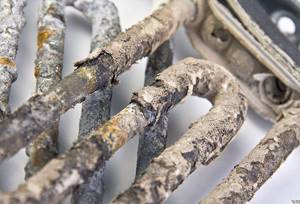
How to properly flush the heat exchanger of a double-circuit boiler?
Mikhail, Ekaterinburg asks a question:
Good afternoon 3 years ago we installed a double-circuit boiler. This is a very convenient device, since the apartment is now warm and there is always hot water. At the time of purchase, I was told in the store that it is necessary to clean the boiler once a year if the tap water is very hard. To carry out cleaning, you need to call specialists, but this costs a lot of money. In fact, that’s why we didn’t clean the installation for so long. Tell me, at what intervals should cleaning be done? And how to rinse the heat exchanger of a double-circuit boiler from lime deposits? Thank you so much in advance for your help!
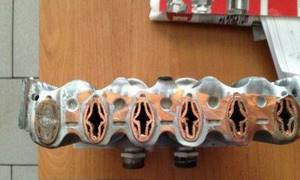
Hello! You should not worry too much, since modern models of double-circuit boilers do not deteriorate at all if you clean them once every 3 years (even if the water is very hard). The main thing #8211 is not to start the process until 5 years of use. The fact that the store advised you to clean it once a year is only partially correct. But this makes no sense, since you will only waste money again. The ideal option #8211 is to carry out such work once every 3 years, subject to constant use of the boiler.
It is necessary to understand how to rinse the heat exchanger under a double-circuit boiler correctly. There are several cleaning methods. The most effective is considered to be standard washing using a special liquid that is capable of peeling off limescale deposits from the internal walls of a given installation.
Before you get to work, you need to turn everything off. To begin, turn on the tap at the bottom of the boiler, which ensures the flow of cold water into it. Next you need to reduce the pressure to zero. If there is no such relief valve, skip this step. Now be sure to disconnect the boiler from gas and electricity. This must be done to ensure your safety. If possible, immediately drain the water from the boiler.
Now you need to remove the casing from the boiler. To do this, you need to unscrew the four nuts at the bottom. Please note that water may flow from below. Therefore, it is recommended to do this over a large basin or even take the boiler outside, first removing it from the hinges on the wall. Unscrew the heat exchanger slowly to avoid damaging the parts.
Next, the heat exchangers are washed. This can be done with ordinary running water. You will see for yourself when the water becomes cleaner after washing. Absolute clarity will indicate that the majority of the flushing was successful. Now you can rinse everything with boiled cold water.
Now it's time to use the cleaner. A special liquid for flushing circuits is purchased in advance, which eliminates deposits on parts. This liquid is poured into two basins, then the contours are placed in these basins so that their entire surface is covered with the product. Leave it all for 15-20 minutes. But before that, read the instructions carefully. After all, some products may require more or, conversely, less time for settling.
After this, the circuits are pulled out of the containers. Now, instead of liquid, you need to pour boiling water with washing powder diluted in it into the basins. The amount of powder should be sufficient. Place the heat exchangers in this solution for 3-5 minutes.
Now all you have to do is rinse the contours several times so that there are no traces of concentrate and powder left.
Flushing the double-circuit boiler can be considered complete. All you have to do now is install the heat exchanger in place. To do this, you first need to install new rubber gaskets, even if the old ones are still quite suitable.
Then everything needs to be returned to its place, trying to tighten the nuts as tightly as possible. A good way to do this is to use a wrench. Once everything is assembled, hang the cauldron back on the hooks. Then you can connect the installation to gas, electricity and water. You are convinced that figuring everything out is not so difficult. And if difficulties arise during assembly or disassembly of the circuits, you need to refer to the instructions. There is a diagram where everything is shown in detail, so it is almost impossible to get confused.
What stages do we go through when cleaning industrial boilers?
Hydrodynamic boiler flushing has a mandatory 9 stages. Here they are.
1. Draining water from the boiler
2. Opening the hatches of the upper and lower drums
3. Dismantling the steam separator
4. Cleaning of each boiler tube by a specialist located inside the upper drum
5. Final washing of the upper drum.
6. Cleaning screen and convection pipes
7. Opening and washing the collector
8. Washing the lower drum
9. Removing sludge and scale from the lower drum.
Chemicals for cleaning and prevention
Descaling agents contain organic or inorganic acids. In the production of household products, adipic and orthophosphoric acids are most often used. At home, prepare aqueous solutions of citric or acetic acid.
Acids are reagents - they are capable of reacting with alkaline earth salts and forming other water-soluble salts, which are then removed from the heat exchange equipment.
Alkalies are also used, for example, soda ash or caustic soda, which loosen carbonate deposits and soot, facilitating subsequent mechanical and chemical cleaning. Alkaline solutions are also used to neutralize traces of acid remaining in the heat exchanger after descaling.
Most reagents are supplied to customers in the form of highly concentrated aqueous solutions and require additional dilution with water in certain proportions specified in the instructions for use.
It is necessary to follow the manufacturer's instructions for preparing the working solution and not exceed the concentration of the product. Otherwise, contact of heat exchange equipment materials with an aggressive substance will lead to accelerated corrosion.
When choosing products, take into account the material of the heat exchanger. This is usually copper, stainless steel or cast iron. For example, Aminat D is intended for heat exchangers made of stainless and carbon steels. Another reagent from the same series, Aminat D(K), is used to clean copper surfaces.

Many domestically produced boilers have copper heat exchangers installed. When choosing an anti-scale agent, make sure that it is approved for use on non-ferrous metals
Universal products include citric acid, vinegar, Medesk-Plus, Trilon B. They are used for washing heat exchangers made of non-ferrous metals and stainless steel.
Trilon B is the disodium salt of ethylenediaminetetraacetic acid. It appears as a white crystalline powder. When Trilon B interacts with alkaline earth salts (scale), calcium and magnesium ions are replaced by sodium ions. As a result, sodium salts are formed, which are highly soluble in water.
Products are produced that have a complex composite composition. They simultaneously contain components that clean scale and prevent its formation.
The KKF composite differs from other chemical agents in its principle of action. It is not a solvent like acids, but in its presence self-cleaning of carbonate deposits (scale) occurs.
Under normal conditions, calcium carbonate crystals form as mineral deposits. This is scale. In the presence of CCF, instead of mineral plaque, another modification of calcium carbonate is formed - aragonite.
Acicular crystals of aragonite destroy calcium deposits as they grow. In contrast, aragonite has weak adhesion to the surface of the heat exchanger and is therefore easily removed by washing with ordinary water.
The active ingredients of CCP already at the initial stage prevent the formation of calcite crystals. As a result, scale formation is significantly slowed down or completely suppressed. This process is called inhibition (translated from Latin: “delay”).
KKF inhibits not only scale, but also corrosion due to the formation of a protective film on the metal surface. When purchasing anti-scale products, do not forget to check whether they have Rospotrebnadzor certificates.
Anti-scale filters
The market offers the consumer a really large number of products against thick plaque, but this certainly does not apply to high-quality protection against this negative phenomenon. Anti-scale filters are the only effective weapon against limewater. There are not many of them, but, nevertheless, the consumer has plenty to choose from, including in price categories.
Two factors will help you choose the right filter for purifying water from scale - an analysis of the state of the water, and setting the correct purpose for using the future softening filter. The consumer can try to save money at the stage of checking the water condition, based solely on his own subjective observations. But suspicions will not give exact numbers. They will not fully describe the volume of excess impurities in the water, they will not make it possible to determine what kind of power treatment devices should be installed and, of course, the absence of an analysis stage will not make it possible to identify such specific impurities as a high threshold of iron content or bactericidal water. When the water is already contaminated, but still has external regulatory characteristics.
The second aspect is purpose. Drinking soft water is not required in the entire water supply system in the apartment. Just like drinking quality, technical water is definitely not necessary. And therefore, thin drinking filters are definitely not required to purify all the water in the apartment. To protect your washing machine from scale, you definitely don’t need to install a reverse osmosis device. At a low threshold for exceeding limescale, citric acid may well become a means of protecting against scale for such household equipment. But, as a rule, there is almost no natural soft water in nature. And even on the territory of Russia, few regions can boast of such water, except Leningrad.
At the same time, if you need to save money at the initial stage, then a conventional ion-exchange jug will be sufficient for domestic drinking water production. Although it has replaceable parts, the quality of softening for home use in food is more than enough. This is one of the most successful, high-quality drinking quality softeners.
An electromagnetic softening device will help you obtain soft industrial water without much expense.
Electromagnetic filter
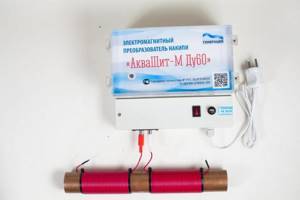
The most convenient and affordable softener for all water in an apartment or house today remains an electromagnetic device. If protection of heating elements from scale is required, then the electromagnet has no equal. It will not only prevent deposits of harmful salts on the surfaces of expensive household appliances, it will also gradually remove all old deposits of this kind.
A fundamental role in this device is played by a good permanent magnet made of rare earth materials. It is able to create a more or less constant magnetic field for many decades. The power of which is maintained by an electrical processor. The operation of such a device can only be disrupted by some kind of demagnetizing device or serious damage to the housing.
The softening process is quite simple. A magnetic field penetrates limewater. Under powerful irradiation, salts undergo changes, becoming needle-shaped balls of very small size. In its new guise, it won’t stick to surfaces much. But the uneven needle-like edges help to gradually loosen the old sediment. And all this happens without human participation. This double effect has become the hallmark and main advantage of Aquashield electromagnetic filters. After all, other devices could not and do not know how to soften water and remove old scale at the same time.
But such a filter is not enough to obtain drinking water, because direct filtration of harmful salts does not occur here. But for systems such as boiler rooms and heating, this option is one of the best and most convenient.
Magnetic filter
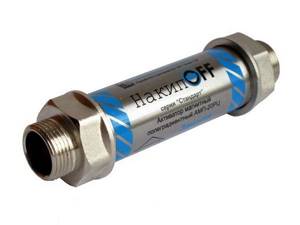
A conventional magnetic water converter MPV MWS could become an excellent competitor to an electromagnet. But the number of shortcomings that this device shows cannot make it an industry leader. The magnets must be strictly placed opposite each other and pressed tightly end to end. In addition, the magnetic field undergoes changes in its operation as a result of slight deviations from the norm.
If the flow in a pipe includes several directions, the lines of force become useless. The same thing happens when the temperature rises to 40 degrees and above. Standing water, as well as water with a high flow rate, cannot be softened with such a device. Therefore, magnetic filters can be used in rare cases. In addition, they must be mounted strictly vertically or strictly horizontally. Protecting water heaters from scale using a magnetic filter makes sense only if there is an electrical processor inside that significantly improves the constant operation of such a field.
Polyphosphate anti-scale agent for washing machines and boilers
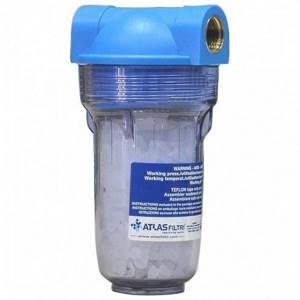
Problems with scale occur not only among those who use hot and cold water from a centralized water supply system. Often, the use of a gas boiler to heat water also makes adjustments to the lives of consumers. Protecting a gas boiler from scale is not only about softening water, it is also about constantly working with carbon deposits, soot and other delights of an open fire.
Very similar to the operation of ion exchange resin, it softens water and polyphosphate filters. They are a flask filled with polyphosphate, which easily reacts with lime water and easily releases its polyphosphate salts. And such a reaction does not require temperature or any stimulus. The polyphosphate coating on the ions of calcium-magnesium salts prevents them from being deposited on the surfaces of the equipment; they are simply washed out of the equipment.
Causes of scale formation
The appearance of scale and salt deposits on the inner walls of the boiler elements and heating circuit is the most common cause of breakdowns of boiler equipment.
The main reason for clogging of the heat exchanger and pipes is the water circulating in the circuit. If the water has not been previously purified from impurities of rust, calcium carbonate, magnesium ions and other substances, it will cause contamination of the circuit and narrowing of its lumen.
Scale is nothing more than a deposit of salts that is formed as a result of the interaction of impurities with the inner surface of the heat exchanger and heating pipes
Please note that the thicker the layer of scale covering the walls of the heat exchanger, the more intense the process of further deposition.
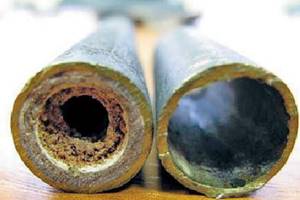
As a result of the accumulation of sediment and scale inside the pipes, they increasingly lose their ability to transfer heat, so that the coolant pressure decreases.
It is worth noting that every 1 mm of salt deposits increases fuel consumption by 10%.
What boilers do we clean?
We clean all types of boilers:
Steam drum boilers with natural circulation: E-1-0.9, E-1.6-0.9, E-2.5-0.9, DE-2.5-14, DE-4-14, DE -6.5-14, DE-10-14, DE-16-14, DE-25-14, DKVR-2.5/13, DKVR-4/13, DKVR-6.5/13, DKVR-10 /13, DKVR-20/13, KE-10-14, KE-16-14, KE-25-14, ShB-A-5, ShB-A-7 and others.
Water-heating water-tube boilers: KVGM-10, KVGM-20, KVGM-30, PTVM-30, NR-18, ZIO-60, E-5 D II, Fakel, Universal and others.
Fire tube steam and hot water boilers: BOSH UL-S, Booster, ICI, Mightyterm, Unical bahr, VIESSMANN, Buderus and others.
Boiler cleaning methods
There are two ways to flush the boiler from scale and dirt:
- Collapsible is a method that requires disassembling the unit. When using it, contaminated boiler parts are dismantled. These components are then either placed in a container of reagent for several hours and cleaned mechanically, or another cleaning method is used. It all depends on the degree of pollution. Then the elements are put back into place.
- In-place - cleaning is carried out without dismantling parts, directly on site. This procedure is best done with a booster.
Cleaning in place is carried out as follows:
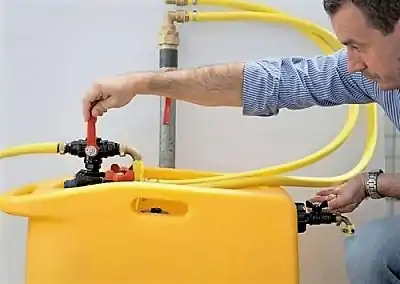
- the boiler is switched off from the fuel supply;
- cools down;
- water is drained;
- the device is disconnected from the heating system;
- the booster is connected;
- pumping of the liquid reagent begins (2-6 hours);
- at the end of this process, the cleaning liquid is drained;
- the boiler is washed with water;
- dried;
- reconnects to the heating system.
For best results, repeat the procedure several times.
Dismantling and cleaning parts
When choosing a dismountable method, in order to prepare a gas boiler for cleaning, you should disassemble it:
- shut off the gas supply;
- disconnect the wires from the gas valve;
- unscrew and remove the boiler door;
- disconnect the wire leading to the piezoelectric element;
- detach the thermocouple and nozzles (be sure to mark the depth of immersion of the nozzles into the burner);

- disconnect the fuel supply pipe;
- take out the burner, unscrew the nuts and remove the top cover.
Key points for cleaning parts:
- Igniter. In order to clean it, you need to turn off the gas, remove the igniter, clean it with a metal brush, blow it out, and put the igniter in place.
- Burner and nozzles. To clean them, you need to turn off the gas supply, remove the burner from its place, mark the location of the nozzles, then carefully unscrew and clean the nozzles with a brush and the burner with a brush. After this, it is advisable to blow out the burner hole using pumping equipment that is at hand, then the nozzle should be inserted back, focusing on the mark, after which the burner is installed in its place.
- The heat exchanger requires cleaning both inside and outside. Water circulates inside, and the main blockages are located there. From the outside, the heat exchanger becomes contaminated with soot, which negatively affects its operation. You can clean the device from soot mechanically; a scraper, a metal brush, or pipe cleaners are suitable for this.
Important! When cleaning, do not use tools with sharp edges, otherwise you may damage the boiler parts. Heat exchanger cleaning steps:
Heat exchanger cleaning steps:
- gas supply is turned off;
- the heat exchanger is removed;
- cleaning is carried out with any mechanical tool;
- the heat exchanger is installed in place.
Procedure for flushing a gas boiler
So, you have decided what to wash with, so we proceed with the following sequence of actions.
1. Silence the object being washed. In Russian - turn off the taps supplying water to the boiler and at the outlet of the boiler. Ideally (and this must be taken into account at the design stage!), so as not to have to worry about connecting later, you need to provide two ball valves at the inlet and outlet of the boiler, to which you can easily connect a chemical pump.
One smart person, for example, did this:
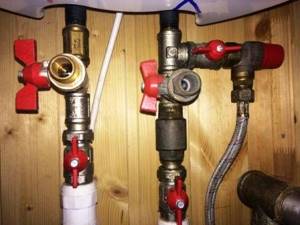
In the picture you can see two groups of taps and one tap on the side (safety valve). For flushing, the lower two taps (direct, return) are closed, and the pump is connected to the upper two taps. All! Elementary and brilliant! Connection – 5 minutes. And there is no need to drain water from a 50-liter boiler, which is already hot and ready for use...

Pictured: AEG 50 boiler shown
So, if you have taps for flushing, connect a pump to them; if taps are not provided, look. As a rule, on wall-mounted boilers you need to disconnect the supply and return. Be careful, sometimes installers do everything so close that you can damage pipes and connections, especially if they are plastic. I hope you remembered to turn off the water supply before disconnecting the pipe!
On floor-standing boilers, at the bottom at the back of the boiler, as a rule, there is a drain (drainage) where you can connect the return line, and on the boiler there is a safety valve with a pressure gauge where the supply hose is connected.
See, for example, how this is implemented on the Viessman Vitogas 050 boiler:
Be careful, the system operates under pressure, so first of all, stop the pumps, shut off the forward and return lines, release the pressure, and only then start connecting.
So, in the end, you should end up with this:
Oh, by the way, why is the pump higher than the boiler? The fact is that when one person works and the capacity of the expansion tank is only 14 liters (versus 67 liters of water in the boiler), you have to be very careful to keep the expanding liquid within the expansion tank. And a pump with a tank installed above the boiler helps with this...
We check the tightness - fill the expansion tank of the pump with water and turn on the pump, no chemicals yet. Let's see how it works, whether there are any leaks at the connection points.
How to detect?
The presence of scale during heating with a heating boiler unit can be visualized by dismantling and partially disassembling it. However, in this case the warranty and service are lost. In addition, it is necessary to involve specialists to prevent damage to the structure.
Another detection method can be called indirect, since it can be implemented without disassembling the boiler itself. To do this, you need to turn off the boiler, wait until it cools down, and then unscrew the nut on the heating circuit pipe, drain the water and examine the condition of the inner surface. If scale is present, white deposits or salt flakes will be visible.
What are our basic principles when cleaning boilers?
In its work, our company adheres to the following basic principles:
- Providing the best possible quality.
- Guarantee of the safety of the technologies and reagents used for the boiler being cleaned.
- Creating maximum convenience for the client when working with us at all stages of interaction.
- Taking into account the client’s wishes regarding the cost and timing of the work.
- We are interested in reducing costs for our clients by jointly performing some operations.
When does a gas boiler need flushing?
To understand whether a gas boiler needs cleaning, it is important to pay attention to the following points:
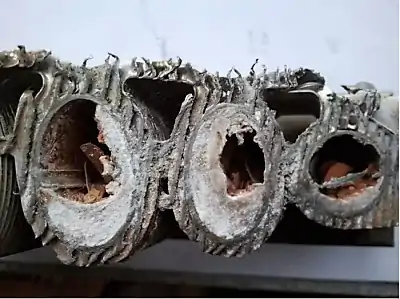
- increasing the time to heat the room (at the same air temperature outside the window);
- difficult operation of the circulation pump;
- drop in water pressure in the tap - if a double-circuit boiler is used;
- uneven heating of batteries, pipes and other heating elements;
- overheating of the heat exchanger - occurs when return water is difficult to return;
- crackling, micro-explosions and other sounds that should not exist.
Attention! In a country house or cottage, the gas boiler operates around the clock throughout the winter period. This means that flushing should be done annually at the end of each heating season.
Which pump should I use to flush a gas boiler?
Let's look at a few options:
1. If you want to assemble a flushing circuit, you will need an expansion tank, pump, hoses. It is better to take a stainless steel pump so that it can be used repeatedly.
It is forbidden to flush boilers with household circulation pumps to avoid their damage!
2. Buy a chemical pump for flushing boilers and heat exchangers. This equipment is a single unit in which a pump with hoses (forward and return lines) is mounted on the expansion tank. Models vary in expansion tank volume and cost. For wall-mounted boilers, the younger model – 15 liters – is quite enough. For floor-standing boilers, it is advisable to take a pump with an expansion tank of 20 liters or more.
The cost of chemical pumps is quite high - from 40,000 rubles.
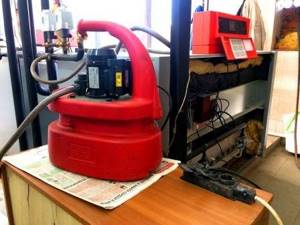
Pictured: professional chemical pump with 14 liter tank
3. Rental of a chemical pump. In principle, we can provide you with a chemical pump for rent, teaching you all the rules for flushing. Sometimes this is a more preferable option, since, as you have already seen above, prices for chemical pumps start at 40,000 rubles.
Renting a chemical pump for 15 liters costs 5,000 rubles per day. Why per day? This time is simply enough to flush one boiler. Typically, the flushing cycle lasts 3-4 hours.
Why does scale appear?
In other words, it settles as a hard layer on the inner walls of the boiler equipment.
What causes scale to appear? The reason for this clogging is very banal - the use of hard water as a coolant, which is well saturated with magnesium ions, calcium carbonate, iron oxide, as well as various other impurities.
When these elements interact with the internal walls of the heat exchanger, salts or bicarbonates are formed, which are the source of scale. It is also worth noting the important fact that on the walls that are covered with this contamination, scale will appear even faster and faster.
The result of such an increasing action will be a narrowing of the channels for coolant circulation, and this, in turn, leads to a loss of heat transfer and a decrease in pressure.
Important information: 1 mm of scale leads to an increase in fuel consumption by 10%!
Therefore, the following recommendation is very important: removing scale in a timely manner will protect your heating boiler from breakdowns and malfunctions.
Single-circuit or double-circuit boiler - is there a difference?
Varieties of boilers do not in any way affect the time period after which it is necessary to flush the heat exchanger. It is much more important which liquid () circulates in the heating system and which is supplied for hot water supply.
When using process water that has undergone standard purification, the boiler can be flushed no more than once every four years. This removes a layer of scale (which still forms) and deposits that have a more complex structure. If you do not filter water before pouring it into the system, but use ordinary water from a centralized water supply, then flushing should occur more often, at least once every two years. This is due to the high content of chlorine in the liquid, which, upon contact with the heating element, settles in the form of scale.
Some users prefer to use antifreeze as a coolant. This liquid is of higher quality: it does not freeze even at low temperatures, releases heat more slowly, but heats up quickly. Unfortunately, antifreeze is poisonous
, and breaking down into components, leads to damage to metal structures. The heat exchanger through which antifreeze circulates should be cleaned at least once every 1.5-2 years.
Therefore, both single-circuit and double-circuit boilers require timely cleaning of the heat exchanger, the intervals between which are the same in all systems.
In order to clean the bithermal heat exchanger less often, it is necessary to take care not only of the quality of the coolant in the heating circuit, but also of the quality of the water in the DHW system. The water should be pre-purified and filtered. You should also take into account the fact that the process of scale deposition begins at a temperature of 70°C, its rate increases by 2 times with every 10°C increase in temperature. In this case, the process progresses, since the growing layer of calcium impairs heat transfer and the temperature of the heat exchange wall increases.
Cleansing. Method 2
In this method, you need to use a special washing complex. It includes:
- Tank for cleaning composition.
- Pump.
- Connecting hoses.
Stages of operations:
- Boiler shutdown.
- Draining.
- Removing the circulation pump. A washing unit is placed in its position. It is connected with special hoses.
- Preparation of the composition in the tank of the designated complex. The proportions are the same as in the first method.
- Turn on the pump. The composition circulates. It is necessary to control the pressure in this complex. It shouldn't go off scale.
- Draining the composition.
- Rinsing the device with water.
- Dismantling of the washing complex.
- Return to the pump location.
Methods and technologies for cleaning boilers
We use all cleaning methods, but there is no single best technology!
Each method has its own advantages and disadvantages.
Different designs of boilers to be cleaned and their operating conditions determine the use of different methods.
When choosing a cleaning method, the following are taken into account:
- boiler type,
- performance,
- thickness and strength of deposits,
- availability and location of resources (water, electricity),
- climatic conditions at the site,
- the client's wishes regarding the cleaning method.
Below we will describe which methods are used in various cases.
Why does a gas boiler become clogged with soot?
The reasons for the formation of soot in boilers when burning natural gas may be different, but all of them, one way or another, are related to the property of the burned fuel, under certain conditions, decomposing into carbon and hydrogen. Modern heating units require precise adjustment of the burner device, taking into account the intensity of air supply and exhaust of combustion products.
The catalysts for soot formation are:
- Incorrect ratio of gas and air proportions during combustion.
- Poor quality fuel.
To reduce the percentage of soot in the flue gases, you will need to tune the boiler, check and, if necessary, replace the jets, and clean the nozzles from carbon deposits.
The formation of soot due to incomplete combustion of gas can be easily prevented if a specialist is invited to install and adjust the boiler. Every year, during seasonal maintenance, the operating parameters of the burner and the composition of the CO emitted are checked.
How to clean a gas boiler from soot deposits
Clean a gas boiler from soot at home? much easier than removing scale from the internal cavity of the heat exchanger. Carbon deposits are removed using the abrasive method. As a chemical reagent? use regular soda. Cleaning is done with a hard kitchen sponge.
You can dissolve soot with regular boiling water. If the carbon deposit thickness is more than 2 mm, special cleaning agents are used. First, the surface is treated with a metal brush. Through the furrows, the chemical solvent better penetrates the surface and removes soot.
How to clean nozzles on a gas boiler
There are several ways to clean carbon deposits on gas injectors:
- Mechanical method - this is how gas workers clean injectors during regular seasonal maintenance. The ash is removed with a special tool that resembles a curved hook.
- Using chemicals – heavy stains are removed with reagents. For cleaning, the burner device will need to be removed.
- The ultrasonic method is a relatively new cleaning method that allows you to get rid of carbon deposits with minimal consequences for the burner and the nozzles themselves. It is carried out on specialized equipment.
Which gas boiler heat exchanger is less susceptible to scale?
Scale appears on heat exchangers of any type. The rate and intensity of deposit formation depends on the material of the water circuit:
- Cast iron heat exchangers have the best resistance to the appearance of salt and mineral deposits. The service life of boilers is about 35 years. The circuit is made of cast iron, resistant to any aggressive substances.
- The heat exchanger is made of stainless steel and is resistant to corrosion, but after several years of operation, deposits of metal salts begin to appear on the walls of the circuit cavity.
- For copper heat exchangers, the first place in terms of the intensity of deposits is prepared. The process of scale formation is accelerated if aluminum fittings, adapters or radiators are used in the heating or hot water system.
Cost of flushing and cleaning a gas boiler
You can clean the DHW and heating heat exchanger yourself, but at the same time, there is a possibility of damaging the heating water circuit. Further repairs of boiler equipment will cost approximately half the cost of a new unit.
Independent cleaning work will cost the following amount:
- Chemical washing – 300-600 rub.
- Washing equipment (booster), starting from 15 thousand rubles.
- Brushes and sponges for cleaning – 50-100 rubles.
The effectiveness of chemical cleaning performed at home without specialized equipment is low. At best, it will be possible to reduce the scale layer. The risk of breaking something, especially when cleaning a plate heat exchanger for hot water, is very high. For this reason, independent maintenance is impractical and not economically profitable.
The best solution would be to seek help from a specialized service center. The boiler cleaning frequency is:
- Once every 2 years, in urban conditions.
- Every year, when installed in rural areas.
For this reason, companies providing technical support often draw up an annual service agreement, which includes not only flushing the circuit, but also making the necessary adjustments, etc. The cost of the contract, depending on the region, boiler and heat exchanger model, varies, starting from 8 thousand rubles.
Types of water softening filters for gas boilers
To clean the device from plaque and scale, many consumers carry out regular mechanical cleaning of the equipment. However, this measure often leads to faster breakdowns. The safest method of protecting a heating installation is to soften the liquid entering it. For this, experts recommend using filters and softeners. Let's look at the main features of popular cleaners.
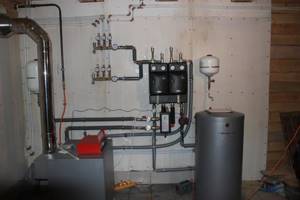
Salt (polyphosphate) filter
The polyphosphate device is an effective and inexpensive softener and cleaner. Its work is based on the ability of its filler – crystals of sodium salts – to neutralize lime impurities. In addition, it traps large debris and promotes the formation of a protective film on the internal surface of the equipment, which prevents the appearance of sediment and inhibits corrosion processes. Main advantages:
- affordable price;
- ease of use;
- high level of protection;
- safety of operation.
However, this salt cleaner needs to be replaced frequently. The approximate period of its use is 12–18 months. Other negative aspects:
- the need to change the reagent approximately once a quarter;
- the liquid cannot be used for household needs, since cleansing and softening occurs using aggressive substances.
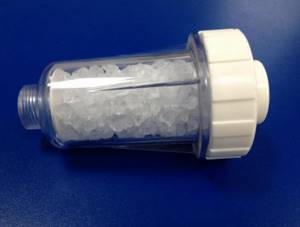
Magnetic cleaner
The action of magnetic installations is based on the ability of magnets to create a field that promotes the disintegration of large salt particles into small ones. The cleaner also prevents impurities from settling on the walls of the equipment. Some of them remain on the cleaning device, and some continue to circulate in the system, but do not settle in the pipes. Thanks to the influence of the magnetic field, the sharp edges of the salts circulating in the pipes help eliminate previously formed deposits.

However, experts consider this cleaner to be ineffective. High temperatures and fluid flow rates reduce the effectiveness of the magnetic field. To enhance the work of a magnet, the force of electricity is used by placing an electrical winding on it.

About the dangers of scale in a heat exchanger
Heating of tap water for a hot water supply system (DHW) in a double-circuit gas boiler or in a gas water heater is carried out in a flow-through heat exchanger.
It is known that when heated above 54 oC, crystallization of salts of chemical elements dissolved in water, mainly calcium and magnesium, occurs. Solid salt crystals settle on the heating surfaces of the heat exchanger and form a strong crust on them.
In addition to hardness salts, scale deposits include other solid particles found in water. For example, rust particles, oxides of other metals, sand, silt, etc.
The amount of salt in water determines the degree of its hardness. There are hard water, which contains a lot of salt, and soft water, with a small amount of salt.
If the source of tap water is a river or other natural body of water, then the hardness of such water is usually low. You are lucky, the water in your home is soft.
Tap water from a well usually contains more hardness salts. And the deeper the well, the more salt there is in the water.
A hard crust of hardness salts, rust, sand, silt on the heating surface of the heat exchanger prevents the transfer of heat through its metal walls. In addition, deposits reduce the clearance of the heat exchanger channels. As a result, the heating temperature and hot water pressure gradually decrease, and the walls of the heat exchanger overheat, which reduces its service life.
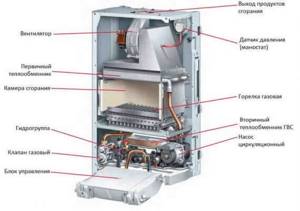
The internal structure of a double-circuit gas boiler using the example of Protherm Gepard 23 MTV and Panther 25.30 KTV (Panther). The secondary DHW heat exchanger is located in the lower compartment.
Double-circuit gas boilers most often have two heat exchangers. One is the primary one, in which water is heated with gas for heating. The other is the secondary DHW heat exchanger, in which heating water from the primary heat exchanger heats the DHW water from the mains.
There are also double-circuit boilers in which both water for heating and water for domestic hot water are heated with gas in one combined bithermic heat exchanger. A bithermic heat exchanger accumulates scale faster, and it is more difficult to clean it from scale.
The geyser has one DHW heat exchanger, in which tap water is immediately heated by gas.
Regular descaling is necessary only for the DHW heat exchanger, in which there is a constant accumulation of deposits of hardness salts.
In the channels of heat exchangers with heating water, scale accumulation occurs only when fresh water is replaced or added to the system. This happens quite rarely and in small volumes.
If there is a filter at the entrance to the heating water boiler, then other dirt from the heating system does not enter the boiler and there may be no need to clean the boiler coolant channels during its entire service life. It is not necessary to descale the primary heat exchanger at the same intervals as the DHW heat exchanger. However, “servicemen”, without proper reason, often insist on descaling the primary heat exchanger, at the same time, just in case. Naturally, they charge for this.
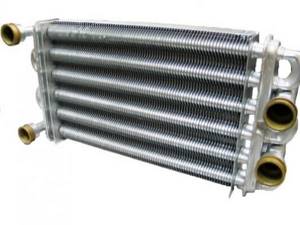
Bithermic heat exchanger of a double-circuit gas boiler. On the right are pipes for heating water. On the left are the DHW water connections. Regular cleaning of scale inside and soot outside is required.

Heat exchanger for DHW gas water heater. Regular cleaning of scale inside and soot outside is required.
Mechanical cleaning of boilers
Mechanical cleaning of boilers is the traditional and most common method of cleaning steam boilers E, DE, KE, DKVR, KRSH, ShB.
This method is widely used due to its simplicity and low cost.
Mechanical cleaning is effective for removing deposits up to 1-3 mm thick!
Equipment for mechanical cleaning consists of an engine, a drive, a flexible shaft and rotating attachments - spreading cutters, drills, brushes.
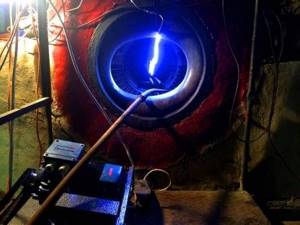
Pictured: equipment for mechanical cleaning of steam boilers
Read more about the mechanical method of cleaning boilers: here.
Basic prices for mechanical cleaning of steam boilers in Moscow and the Moscow region (with scale up to 0.5 mm are shown in the table:
Cost of mechanical boiler cleaning:
| Boiler brand | Cost of mechanical cleaning, rubles | Cleaning period, days |
| E-1.0-0.9 | 55 000 | 1 |
| DKVR-4/13 | 75 000 | 2 |
| DKVR-6.5/13 | 95 000 | 2-3 |
| DKVR-10/13 | 145 000 | 4-5 |
| DE-10-14 | 165 000 | 5-7 |
| DE-16-14 | 185 000 | 5-7 |
How to remove scale from a heat exchanger
To descale at home, I recommend using a 20% citric acid solution (250 g/liter) as a cleaning liquid.
You can also use commercially available special compounds to descale household washing machines and dishwashers. Read the contents of the packaging carefully. The chemical should be designed to remove scale deposits , not to soften water (not to prevent deposits).
Less accessible, but if desired, you can find and buy special compositions (liquid or powder) for professional cleaning of boiler heat exchangers from scale. The selection of such chemicals should be done with caution. There is a wide range of strong chemicals available for cleaning different types of equipment. You can buy a chemical that will corrode the metal or protective coating of the heat exchanger.
Particular care should be taken when choosing a product for cleaning the heat exchanger without removing it from the boiler. The selected chemical composition should not damage not only the metal of the heat exchanger, but also boiler parts made of other metals, as well as parts made of rubber and plastic.
In order not to make a mistake in the choice, I recommend that the home craftsman use a relatively chemically weak and therefore safe, time-tested, accessible and cheap chemical - food-grade or industrial citric acid (250 g/liter).
If deposits do not accumulate, then to regularly clean the heat exchanger from scale, you can even use conventional toilet treatment products containing acid, for example, oxalic acid.
Descaling without removing the heat exchanger from the boiler or column
The following video shows how to assemble a simple device from available materials for cleaning the heat exchanger without removing it from the boiler.
I would like to draw your attention to the following:
- You can take any of the available pumps, including those from used equipment.
- Be sure to install a filter at the pump inlet or after the pump, at the water supply to the boiler. Otherwise, dirt from the container with the solution will go back into the boiler and clog the filter and flow sensor in the boiler.
- It is better to heat the solution to 60 degrees. To do this, you can even turn on the boiler for a short time to heat the hot water supply.
In this option, you should not change the direction of movement of the cleaning solution. It must coincide with the direction of water movement during boiler operation.
You should be more careful when choosing the composition and concentration of the solution to remove scale. Solutions can have a destructive effect on other parts of the boiler, including those made of various metals, plastic and rubber.
Which is the best anti-scale filter for the column? - question in the comments
Manufacturers of geysers prescribe that if the water hardness is above 20º F (where 1º F = 10 mg CaCO3 per 1 liter of water), then you must install a polyphosphate dispenser (filter) or a similar system for softening the water.
When choosing, I recommend reading the technical data sheet of the device. The technical data sheet must indicate in numerical format and with units of measurement the effectiveness of reducing water hardness after the filter. If there are only general words about the purpose, without numbers, then this is a deception.
For example, there are devices on sale that are called something like this - electromagnetic scale converters. In the official document, in the technical data sheet of the device, there is no indicator of a decrease in water hardness after the device. Or another performance indicator that can be verified. The manufacturer does not promise or guarantee anything specific to the buyer. And this is no coincidence!
More articles on this topic:
⇒ How to reduce the high gas consumption of a boiler for heating a house ⇒ Setting up, adjusting the power of a gas boiler ⇒ Malfunctions and error codes of a gas boiler Ariston, Protherm, Baxi ⇒ Either cold or hot water comes from the boiler ⇒ Setting the pressure in a heating system with a membrane expansion tank
More articles on this topic
- Installation of plastic windows at the dacha
- Facade paint for exterior use
- Sewage system with active septic tank Topas for a private house
- Do-it-yourself soundproofing frame partitions made of plasterboard
- Sound and noise insulation of the ceiling in the apartment
- Renovation and redevelopment will change your life for the better!
- The thickness of the walls of a house made of aerated concrete - gas silicate
- Exterior decoration of house walls made of aerated concrete and gas silicate blocks
We recommend
DOCKER THERMO is a concentrated industrial cleaner for cleaning heating systems and heat exchangers .
Recommended for: treatment of boilers, high and low pressure boilers, condensers, heat exchangers, pipelines, for flushing household water heating appliances. More details
Cleaning a double-circuit heat exchanger Pipe cleaner Industrial chemicals for descaling
How to clean the heat exchanger of a floor-standing gas boiler
To disassemble a heating unit at home, you do not need any special tools; a regular set with screwdrivers, keys and pliers is sufficient. Preventive cleaning of the heat exchanger from soot and scale is carried out in the off-season, when the heating of the house is turned off. Having previously shut off the gas supply, we begin disassembling the boiler by removing the burner device in the following sequence:
- Disconnect all wires from the gas valve.
- Remove the thermocouple connected to the gas valve by a capillary tube from the combustion chamber.
- Disconnect the gas supply pipe.
- Unscrew the 4 nuts (or bolts) holding the stove with the burner. Pull the assembly out as shown in the photo:

The gas boiler burner can be cleaned without further disassembly using an old toothbrush. The igniter, piezoelectric ignition device and flame control sensor (if equipped) should also be cleaned of soot. Now you need to get to the heat exchanger, for which you need to remove the top cover of the boiler, disconnect the draft sensor and the chimney pipe.
In the opened opening you will see insulation covering the chimney casing. Carefully remove the insulation, and then unscrew the screws securing the casing and remove it. Below it is a heat exchanger, from which you need to remove steel turbulators, as is done in the photo:

When removing the turbulators from the heat exchanger, the soot spills downwards, so the first thing to do is remove the burner
Cleaning the turbulators is easy; this can be done with a regular brush with metal bristles. But cleaning the heat exchanger of a floor-standing boiler is best done with the help of simple tools made by yourself according to the size of the smoke pipes. If they have a rectangular cross-section, then you need to bend a convenient flat spatula and a small scoop-shaped scraper from thin metal, then nail it to a wooden handle.
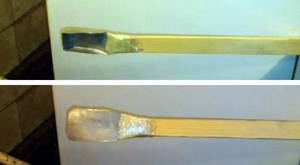
For round flame tubes, these same tools are made slightly curved. First, the walls of the pipes should be cleaned with a scoop, after which the soot remaining in the corners should be removed with a spatula.

At the end of the work, all surfaces of the heat exchanger can be cleaned with a brush screwed to a long handle. The last step is to remove soot from the bottom, where it was poured when cleaning the smoke pipes. This is what a clean heat exchanger of a heating unit looks like:
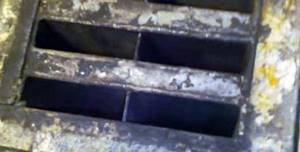
You can take a closer look at how to clean a gas boiler at home in the video:
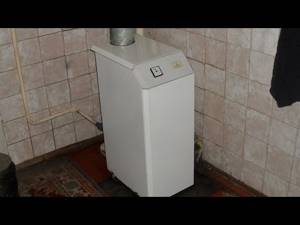
Watch this video on YouTube
What are the differences between cleaning a double-circuit gas boiler?
How to rinse the secondary heat exchanger of a gas boiler with your own hands? There are no fundamental differences between flushing the DHW circuit and the heating heat exchanger. It’s just that in the case of a dual-circuit model, you will have to clean not one, but two elements.
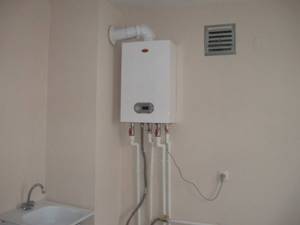
Double-circuit gas boilers can be equipped with two types of heat exchangers:
- removable secondary;
- bithermic.
The first option is cleaned in the same way as the primary circuit using manual or chemical cleaning using a booster:
- connect the booster hoses to the pipes for cold water supply and hot water outlet;
- The apparatus is put into operation with the reagent heated (t=50-55ºC).
For manual cleaning, the secondary circuit is dismantled and immersed in a citric acid solution. Then brush the outside and dry.
A bithermal heat exchanger consists of two pipes inserted into one another: coolant flows through one of them, hot water flows through the other. Cleaning it is much more difficult, especially since such a circuit cannot be dismantled as a separate analogue. Therefore, flushing the bithermal circuit can only be done using a booster. If such an element is heavily contaminated, then it is simply impossible to clean it. Then you will have to buy a new bithermic heat exchanger and install it in place of the old one.

How often to descale the heat exchanger
Equipment manufacturers require maintenance of a gas boiler or geyser to be carried out annually .
I recommend cleaning the heat exchanger from scale at every equipment maintenance, that is, annually.
Some "owners" do not approach the equipment until something happens. But, as a rule, it “happens” at the most inopportune moment. The severity of the damage and the cost of repairs are higher. Some defects, outwardly invisible, lead to an increase in gas consumption over a long period of time.
Read: How to reduce the high gas consumption of a boiler for heating a house.
In the Russian Federation, there are “Rules for the use of gas in terms of ensuring safety during the use and maintenance of in-house and intra-apartment equipment when providing public gas supply services”, approved by Decree of the Government of the Russian Federation No. 410 of May 14, 2013.
In accordance with current rules, in order to ensure the safety of gas-using equipment, household consumers must enter into a maintenance agreement with a specialized organization.
In December 2021, the Code of the Russian Federation on Administrative Offenses was supplemented with Article 9.23, which provides for punishment in the form of a fine of up to 30 thousand rubles for individuals for violating the rules for ensuring the safe use and maintenance of indoor and indoor gas equipment.
Fines are provided for:
- avoidance of concluding a mandatory contract for the maintenance and repair of gas equipment in homes;
- refusal to admit a representative of the organization to perform maintenance; avoidance of concluding an agreement on the performance of work on diagnosing gas equipment;
- avoidance of replacing gas equipment; actions that led to an accident or an immediate threat of harm to human life and health;
- untimely or poor-quality performance of work on maintenance and repair of in-house or in-apartment gas equipment.
I do not recommend home craftsmen to carry out work on the gas duct of the boiler or heater. If necessary, a home mechanic can do some simple work that is recommended to be performed when servicing the boiler.
Read: Gas boiler maintenance
The bithermic heat exchanger of a gas boiler, as well as the heat exchanger of a gas water heater, must be regularly cleaned not only of scale inside, but also of soot deposits outside.
A home craftsman can easily clean the DHW heat exchanger of scale inside and soot outside with his own hands.
Depending on the degree of hardness of tap water, the amount of water used and its heating temperature, the heat exchanger must be cleaned of scale at intervals of 1 - 5 years.
Manufacturers of heat exchangers use various methods that hinder and slow down scale deposits on its walls. For example, they increase the speed of water flow, create a turbulent regime of fluid movement in the heat exchanger, and protect the surfaces of the heat exchanger channels with anti-corrosion coatings and polish them. All these measures, to one degree or another, create a self-cleaning effect, which slows down the process of scale accumulation. But there are no heat exchangers for household gas boilers and water heaters that are completely self-cleaning of scale and never require descaling.
I advise you to do this work annually, in the summer. You should not wait several years until the heat exchanger is covered with a thick layer of scale inside and overgrown with soot on the outside.
You will have to pay for a thick layer of scale and soot with increased gas consumption and reduced equipment durability. In addition, a thin layer of dirt can be removed much easier.
